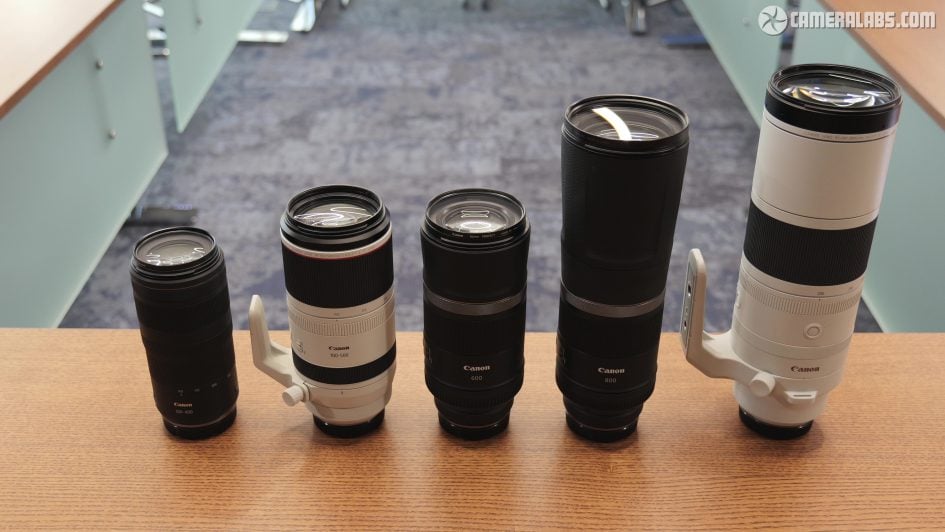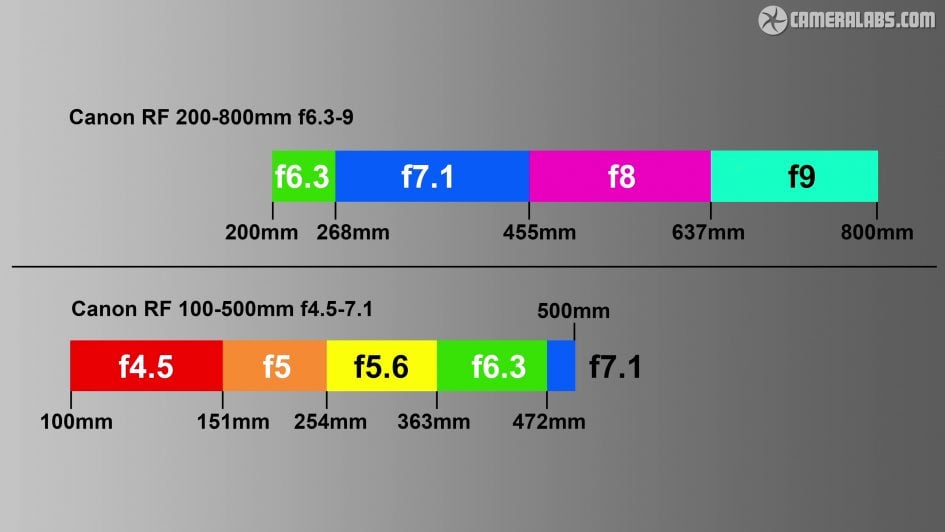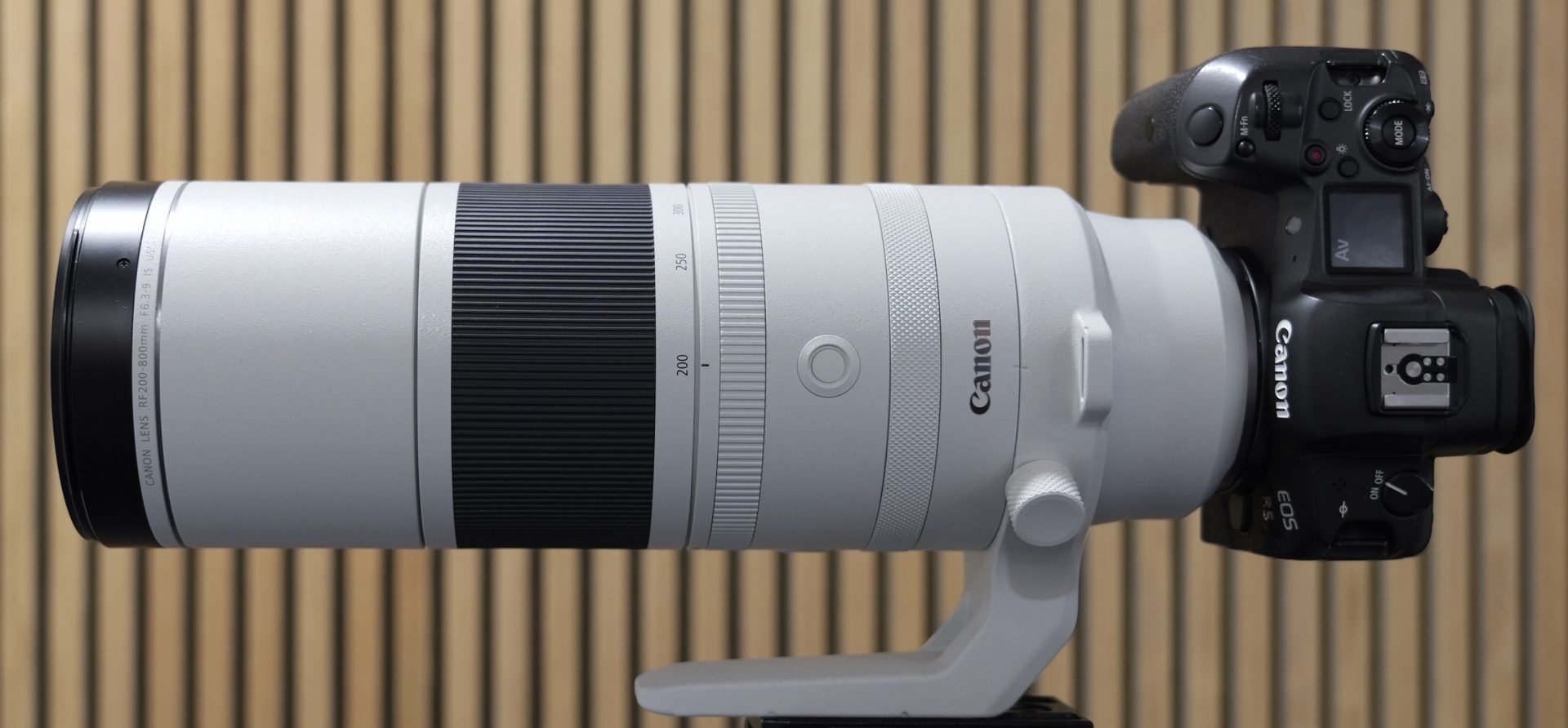Canon RF 200-800mm f6.3-9 review so far
-
-
Written by Gordon Laing
The Canon RF 200-800 f6.3-9 IS USM is a super-telephoto zoom for the EOS R mirrorless system that’s corrected for full-frame bodies. I got my hands-on a pre-production model and in the following video I’ll show you what I know so far. If you prefer to read the written highlights, keep scrolling!
Announced in November 2023, it becomes one of the only full-frame super-telephoto zooms to reach 800mm, making it ideal for distant wildlife and sports.
The 200-800 becomes the third super-tele zoom in the RF system to date, joining the cheaper 100-400 f5.6-8 and more expensive 100-500 f4.5-7.1L.
Unsurprisingly the 200-800 is by far the heftiest of the three, roughly double the length and three times the weight of the 100-400, not to mention 50% longer and half a kilo heavier than the 100-500.
It also joins a selection of long primes, including the RF 800mm f11 which may be similar in diameter, but in its retracted state is 32mm shorter and more importantly roughly two thirds the weight and half the price. That said the 800 f11 prime is two thirds of a stop dimmer in aperture and lacks a zoom capability, but it’s nice to have the choice.

Above from left to right, here’s the RF 100-400, RF 100-500, the RF 600 and RF 800 primes, and finally the latest RF 200-800 on the far right.
At this point I’d normally mention third party options like Sigma’s 150-600 f5-6.3 DG DN, actually similar in weight to the 200-800 despite not reaching as far, but again costing around half the price.
Sadly at the time of making this review though, Sigma’s lenses were still not an option for Canon EOS R, so I’ll keep my finger’s crossed, remind you that you could adapt an older EF version, and move on.
Measuring 102mm in diameter, 314mm long and weighing just over 2kg, the RF 200-800 is certainly a lens you know you’re carrying around.
Reflecting the size and weight, Canon has thankfully fitted a tripod foot with a collar that allows the lens to rotate, albeit lacking any notches to easily find 90 degree intervals.
The foot is non-removable, thereby occupying even more bag space, but you can at least use it as a carrying handle.
With its white barrel, you may assume the 200-800 is a member of the high-end L-series, but it’s actually not – there’s no red ring here. But before you get too concerned over build and accessories for the typical environments where it’ll be used, the 200-800 is sealed against what Canon describes as light weather conditions, and also thankfully comes with a lens hood and a strap too! As for filters, there’s a 95mm thread at the end of the barrel.
In terms of controls, there’s a combined manual focus and control ring, two AF stop buttons with a customisable function, switches for AF and IS, followed by a ring to adjust the resistance of the main zoom ring itself.
The closest focusing distance varies by focal length, starting at 80cm at the 200mm-end, before extending to 1.8m at 400mm, 2.8m at 600mm, and finally 3.3m when zoomed to the 800mm focal length.
Note unlike the RF 100-500, there’s no focus distance limiter switch, nor any panning IS modes to choose from.
Twisting the zoom ring extends the barrel like most lenses in its class, including the 100-400 and 100-500, as well as Sigma’s 150-600. Sony’s FE 200-600 is the exception here, zooming internally. For the record, the 200-800’s barrel extends by about 9cm when set to 800mm.

Above: as you increase the focal length, the aperture gradually dims, again like most super-tele zooms. The 200-800 starts with a maximum aperture of f6.3 at 200mm, before dimming to f7.1 at 268mm, then to f8 at 455mm, before operating at f9 between 637 to 800mm.
Now a maximum aperture of f6.3 to f9 is not going to deliver super shallow depth of field effects or be the best spec in very low light, but it was chosen to make it lighter and more affordable than Canon’s larger aperture super-teles. Think of it as a zoomable and slightly brighter version of the 800 f11 and you’ll be on the right track, and that lens has proven a hit not just on price but portability.
Focusing is courtesy of a Nano USM motor and the lens also includes optical image stabilisation, good for up to 5.5 stops on bodies without IBIS, or up to 7.5 stops for those that do. Note IBIS becomes less effective at very long focal lengths though, so the enhanced stabilisation only applies when the lens is at the 200mm end. Once you reach 800mm, it effectively uses optical stabilisation only for 5.5 stops regardless of the body.
And for anyone who thinks 800mm isn’t long enough, I’m delighted to report the 200-800 is fully compatible with both RF tele-converters, extending the reach to up to 1600mm, albeit with a correspondingly dim aperture of f18. Oh and unlike using TCs on the 100-500, there’s no restrictions to the range.
And amazingly the EOS R bodies will still autofocus at this point, but with a slightly reduced area of 90×100% when using the 1.4x TC, or 40×60% when using the 2x converter. Your subject will need to be inside these reduced frames for autofocus.
If you’re using a cropped body like the EOS R7 for even greater reach, these reductions become less of an issue. Fit the 200-800 with a 2x tele-converter and mount it on an R7, and the grey AF box now represents a larger 60×80% portion of the frame.
Once I get my hands on a final production sample, I’ll add sample images here before following-up with a full video testing and comparing the quality and overall performance.
Right now, the RF 200-800 looks like a promising addition to the growing RF catalogue, for those who desire long reach without sacrificing the flexibility of a zoom. It’s also a long-awaited response to Sony’s 200-600 which for a long time has been a reason for some to adopt that system.
Check prices on the Canon RF 200-800mm at B&H, Adorama, WEX UK or Calumet.de. Alternatively get yourself a copy of my In Camera book, an official Cameralabs T-shirt or mug, or treat me to a coffee! Thanks!




